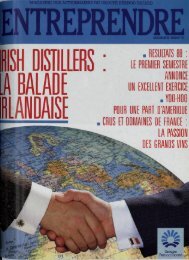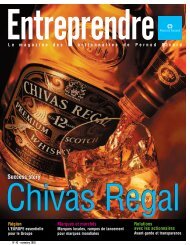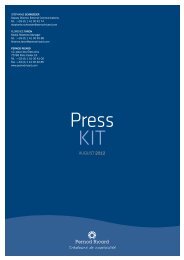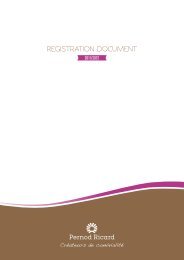Registration Document - Pernod Ricard
Registration Document - Pernod Ricard
Registration Document - Pernod Ricard
You also want an ePaper? Increase the reach of your titles
YUMPU automatically turns print PDFs into web optimized ePapers that Google loves.
Brands recognised in the context of business combinations – The<br />
fair value of identifiable acquired brands is determined using an<br />
actuarial calculation of estimated future profits or using the royalty<br />
method and corresponds to the fair value of the brands at the date<br />
of acquisition. As the Group’s brands are intangible assets with<br />
indefinite useful lives, they are not amortised but are rather subject<br />
to an impairment test at least once a year and as soon as there is an<br />
indication that their value may have been impaired. Brands acquired<br />
as part of acquisitions of foreign entities are denominated in the<br />
functional currency of the acquired activity.<br />
8. Property, plant and equipment<br />
Property, plant and equipment are recognised at acquisition cost and<br />
analysed by component. Depreciation is calculated on a straight-line<br />
basis or, in certain cases, using the diminishing balance method over<br />
the estimated useful life of the assets. The useful life is reviewed on<br />
a regular basis. Items of property, plant and equipment are written<br />
down when impaired; i.e., when their recoverable amount falls below<br />
their carrying amount. The average depreciable lives for the major<br />
categories of property, plant and equipment are as follows:<br />
Buildings 15 to 50 years<br />
Machinery and equipment 5 to 15 years<br />
Other property, plant and equipment 3 to 5 years<br />
In accordance with IAS 17, assets acquired under finance lease<br />
contracts are capitalised, and a corresponding lease obligation<br />
liability is recognised, when the lease contract transfers substantially<br />
all the risks and rewards related to the asset to the Group. Buildings<br />
which have been subject to sale and lease back contracts are treated<br />
in a similar manner.<br />
Depreciation of property, plant and equipment is recognised within<br />
operating profit in the income statement.<br />
9. Impairment of non-current assets<br />
In accordance with IAS 36, intangible assets and property, plant and<br />
equipment are subject to impairment tests as soon as there is an<br />
indication that the value of the asset has been impaired and at least<br />
once a year for non-current assets with indefinite useful lives (goodwill<br />
and brands). When the carrying amount of these non-current assets<br />
becomes greater over a sustained period of time than the highest of<br />
either their value in use or their market value, an impairment loss is<br />
recognised within operating profit.<br />
Assets subject to impairment tests are included into Cash-Generating<br />
Units (CGUs), corresponding to linked groups of assets, which<br />
generate identifiable cash flows. The CGUs include assets related<br />
to the Group’s brands and are allocated in accordance with the four<br />
geographical areas defined by the Group, on the basis of the sale<br />
destination of the products.<br />
When the recoverable amount of a CGU is less than its carrying<br />
amount, an impairment loss is recognised within operating profit.<br />
The recoverable amount of the CGU is the higher of its market value<br />
and its value in use. Value in use is calculated using profit projections<br />
over a 20-year period, prepared using management forecasting tools<br />
(for the first 3 years) and using an estimate for the following years<br />
based on long term trends by market of the brands in question. The<br />
calculation includes a terminal value which is determined in light of<br />
the growth and profitability profile of each brand.<br />
ANNUAL CONSOLIDATED FINANCIAL STATEMENTS 4<br />
Notes to the annual consolidated fi nancial statements<br />
The discount rate used for these calculations is an after-tax rate<br />
applied to after-tax cash flows and corresponds to the weighted<br />
average cost of capital, which amounted to 8.33% at 30 June 2009<br />
compared to 7.2% at 30 June 2008. A different discount rate was used<br />
to allow for risks specific to certain markets or geographical areas in<br />
calculating cash flows. Assumptions made in terms of future changes<br />
in sales and of terminal values are reasonable and in accordance with<br />
market data available for each of the CGUs. Additional impairment<br />
tests are applied where events or specific circumstances suggest that<br />
a potential impairment exists.<br />
10. Foreign currency translation<br />
10.1 Reporting currency used in the<br />
consolidated financial statements<br />
The Group’s consolidated financial statements are prepared in euro,<br />
which is the functional currency and the reporting currency of the<br />
P arent C ompany.<br />
10.2 Functional currency<br />
The functional currency of an entity is the currency of the economic<br />
environment in which it mainly operates. In most cases, the functional<br />
currency is the entity’s local currency. However, in certain entities, a<br />
functional currency different from the local currency may be used if it<br />
reflects the entity’s economic environment and the currency in which<br />
most of the entity’s transactions are denominated.<br />
10.3 Translation of transactions<br />
denominated in foreign currencies<br />
Transactions denominated in foreign currencies are translated into<br />
the functional currency using the exchange rate applying at the<br />
transaction date. Non-monetary assets and liabilities denominated<br />
in foreign currencies are recognised at the historical exchange rate<br />
applicable at the transaction date. Monetary assets and liabilities<br />
denominated in foreign currencies are translated at the exchange rate<br />
applying at the balance sheet date. Foreign currency differences are<br />
recognised in profit and loss for the period, except for foreign currency<br />
differences arising on debts designated as hedges for the net foreign<br />
currency assets of consolidated subsidiaries. These latter differences<br />
are recognised directly in currency translation adjustments, within<br />
shareholders’ equity, until the disposal of the net investment. Foreign<br />
currency differences related to operating activities are recognised<br />
within operating profit for the period; foreign currency differences<br />
related to financing activities are recognised within interest (expense)<br />
income or in shareholders’ equity.<br />
10.4 Translation of financial statements<br />
of subsidiaries whose functional<br />
currency is different from the euro<br />
(the reporting currency)<br />
The balance sheet is translated into euros at year-end exchange rates.<br />
The income statement and cash flows are translated on the basis of<br />
average exchange rates. Differences resulting from the translation<br />
of the financial statements of these subsidiaries are recognised<br />
in currency translation adjustments within shareholders’ equity.<br />
On disposal of a foreign entity, currency translation adjustments<br />
previously recognised in shareholders’ equity are recognised in profit<br />
and loss.<br />
I REFERENCE DOCUMENT 2008/2009 I PERNOD RICARD 83
















